SA Science Lens 2019/2020
Results
The South African Science Lens® competition celebrates the wonder of science through photography, and shows how science and art can be seamless allies in communicating about the world around us.
The South African Agency for Science and Technology Advancement (SAASTA), a business unit of the National Research Foundation, and its partner in the 11th round of the SA Science Lens® competition, the Human Sciences Research Council (HSRC), are pleased to announce SA Science Lens® the winners of the latest round of the competition. This year was the first time SAASTA and the HSRC collaborated to present the photographic competition, celebrating all natural and social sciences in the 20-year anniversary of the NRF and the 50-year anniversary of the HSRC.
Through the SA Science Lens® competition, SAASTA and the HSRC aim to encourage researchers and scientists to invite the public into their world through inspiring curiosity in beautiful, dramatic or interesting photographs of their research. The competition also aims to encourage the public to appreciate and find science in their everyday lives, showing how they can view the world around them from a scientific perspective.
Winners Announced!!
- SCIENCE AS ART
- SCIENCE CLOSE-UP
- SCIENCE IN ACTION
- THE DIGNITY OF ALL SOUTH AFRICANS
First Place – “Meowy” Muse by Kervin Prayag
This photo was taken during a caracal (Caracal caracal) necropsy conducted by Dr Laurel Serieys and PhD student Gabriella Leighton at the University of Cape Town, as part of the Urban Caracal Project. Necropsies are done to determine the likely cause of death, collect data on morphology, and to obtain samples for disease and pesticide testing. Here we see artist Sujay Sanan making a rough anatomical sketch of a caracal during this necropsy. This was part of preliminary work for his final watercolour paintings that were on display at the “A Place I Know” solo exhibition. The paintings at this exhibit diarised the landscapes, flora, and fauna of the Western Cape, in a somewhat unique way. In the artist’s own words, “while these works document what I fear might be lost, they are also filled with optimism”. Such research being done to understand the deaths of these animals is important and positive for wildlife conservation.
Second Place – “Floral surgery” by Jonathan Du Toit
A dental implant osteotomy drilled into the lower jaw of an elderly female. This was the bone reamer - a tool to cut the more compact cortical bone. The photo was taken after the implant drill was removed from the hole it cut into the bone. Bone became lodged in the flutes and here you can see the bone peeling out of these flutes. This is a unique glimpse into the science and art of dental implant surgery, transforming a surgical procedure that is usually quite gruesome to the layperson, into something beautiful and peculiar - something like a flower.
Third Place – “Relative motion” by Morgan Trimble
This image captures the unique motion of the SA Agulhas II, one of the finest ocean-going research vessels in the world, as an abstract starscape. To create this image, very slow shutter speed was used when most of the ship’s lights were off for astronomical observations at night. With very little light pollution out at sea, stargazing is amazing, but look too intently and you might start to feel a little seasick. The camera was pointed straight up at the night sky from a tripod that kept the camera motionless relative to the ship. But the ship was moving through the Agulhas Current. These squiqqles of light—the stars—capture the pitch, roll, and yaw of the ship over thirty seconds reflected in the Milky Way. The light trails differ in colour because of the different wavelengths emitted by different temperature stars as well as differences in elemental composition. This photo was taken during SEAmester, an educational opportunity for South African postgraduate students from all over the country to join a research expedition while completing coursework in marine biology and oceanography.
Third Place – “Glow rings” by Bjorn Coetsee
Incorporating phosphorescent glow powders in jewellery, like these rings, creates unique and visually appealing, one-of-a-kind art pieces. Phosphorescence is a process in which energy absorbed by a substance is released relatively slowly in the form of light. Strontium aluminates are the most popular modern phosphorescent materials and exhibit a long afterglow at room temperature with a broad spectral distribution of luminescence in the visible range. They are about 10 times brighter and 10 times longer glowing than the predecessor, copper-activated zinc sulphide. SrAl is also used in a wide range of industrial applications such as traffic and emergency signs, biological markers, and as luminous paints in airports, highways and buildings.
First Place – “Happy Faces” by Prof Bruce Cairncross
The half-comedy theatrical mask central in this image and a few apparent facial expressions surrounding it are formed by a purple-white, sugary substance that partially covers cavities in a brown matrix. The face is anthropomorphic because while appearing to be human, it is inorganic and consists of different geological minerals. The brown matrix is the mineral goethite, an iron-hydroxide, typically dark-brown, while the white and purple crusts are tiny crystals of fluorite, a calcium fluoride species, that together fortuitously form the faces. This sample, that measures 4 cm across, comes from a fluorite mine in the Gauteng Province of South Africa.
Second Place – “Monkey beetle business” by Morgan Trimble
Cape Town has recently been declared the world’s most biodiverse city. It is also the city with the most threatened species, and the Western Cape Province is behind only the Hawaiian Islands in terms of plant species extinctions. Most of Cape Town’s incredible biodiversity comes from plants, and so setting aside the space for them to continue growing and evolving in a changing climate is important. But it’s not enough just to conserve space for the plants. The pollinators are also crucial. Some plants depend on a certain pollinator species or type of pollinator. This photo shows a monkey beetle embedded in a yellow flower. There are more than 1,000 monkey beetle species in South Africa, representing 65% of the world’s monkey beetle species. Scientists have identified three different guilds of monkey beetles that play various roles in pollination for plant species, dependent on flower colour and beetle behaviour. This flower and beetle were tiny, about the size of a fingertip. But flowers and their pollinators cover a huge range of shapes and sizes.
Third Place – “Poisonous beauty: dog food gone wrong” by Neriman Yilmaz
One sometimes needs a microscope to spot beauty. As mycologists, we characterize fungi using a microscope and come across many beautiful features. In this image, you can see the fungal diversity on dog food pellets kept in a damp chamber for three days. Fungi are the second most species-rich organism group after the insects. Molecular studies showed that fungi are more closely related to animals than plants in the tree of life. The kingdom Fungi includes organisms such as mushrooms, yeasts, moulds, lichens, rusts, and smuts. Fungi play a key role in the ecosystem as decomposers. Fungi have a very important role in food and drink production. Fungi can also produce the toxic compounds named mycotoxins. The word has a Greek origin, “myco” for fungus and “toxin” for poison. There are more than a hundred known mycotoxins, but most countries have regulations for only five of them. It is estimated that 30% of crops are contaminated with mycotoxins, which causes a huge loss to countries’ economies. Some mycotoxins can cause cancers. In this photo Aspergillus flavus, a fungal species that produces carcinogenic aflatoxin, can be seen in the centre with the light green colour. Around it, the dog food is covered with another xerophilic Aspergillus species, A. glaucus.
Third Place – “Purple flower” by Bjorn Coetsee
This image shows a close up cannabis plant in her flowering phase turning purple. Chlorophyll gives plants its green colour and is vitally important to the photosynthesis process by which plants absorb sunlight for energy. Why would cannabis turn purple? Anthocyanins are a family of flavonoids that provide purple, red, or blue pigments (also found in blueberries, eggplants, red cabbage, concord grapes, violets, and other richly-coloured plants). Some cannabis strains genetically contain higher levels of anthocyanins than others. As cannabis plants mature, they produce less of the dominant pigment chlorophyll and we begin to see the anthocyanins emerge in a show of purples, reds, and blues. A second reason for cannabis turning into different colours are temperature changes. A sudden drop in temperatures will halt chlorophyll production and more anthocyanins begins to emerge, which turns the cannabis plant into a different vibrant colour. One might expect these vibrant colourful cannabis plants are more potent, but it doesn’t increase the psychoactive tetrahydrocannabinol (THC) production.
First Place – “Small scale surgery” by Thilo Beck
The white-browed sparrow weaver (Plocepasser mahali) is a tiny bird, living in the arid areas of southern Africa. Researchers are trying to understand their ecology by looking at their thermal regimes. To do so miniature data loggers are implanted into the birds. To make the procedure easier and less stressful for the birds, a researcher will go out at night to catch them in their roosting chambers, anaesthetise them, make a tiny incision, insert the data logger and stitch them up all within a few minutes. There is a big trade-off between the size, the battery of the logger and its capacity to store the data. The logger should be able to record enough data so the bird doesn’t need surgery too often, while it has to be small enough to not constrain the bird in its movement, particularly its flying abilities. Only in the last few years, it has been possible to build small enough loggers to fit them into small birds without constraining them. This pilot study is the first time that data loggers are being put into white-browed sparrow weavers with the aim to try to understand a small piece of the Kalahari ecosystem.
Second Place – “The Release” by Declan Porter
This image depicts a Black-footed Cat (Felis nigripes) being released from a tomahawk cage trap during a species richness and genetic survey on Samara Private Game Reserve and surrounding farms in October 2019. Due to the varying size of mammals in South Africa, different techniques are used to accurately and effectively survey species richness. In this research project, tomahawk cage traps were used to trap small carnivores. Once caught, the species of animal was recorded and a small genetic sample of hair was taken to be added to a genetic biobank for each species caught. This contributes to the understanding of the distribution and presence of a species in an area, and allows for further genetic analysis through the use of the genetic sample taken for the biobank.
Third Place – “Laser shock processing technology being used to straighten a winglet spar of a business jet, which resists bending loads” by Pieter Uys
This shows laser shock processing technology being used to straighten a winglet spar of a business jet, which resists bending loads. Laser shock processing is a new type of surface modification technology that can improve the fatigue life of materials by using laser-induced plasma shock waves. It has the advantages of a significant strengthening effect, strong controllability and good adaptability.
Aligned laser shock hiyi nwana ya ti nxaka letinthswa ya thekinology ya mayemo ya xiyimo xale hansi leyi kombisaku ku antswisiwa ka vutomi kaleti karhalaku tirhisa gandlati ra SHOCK PLASM lowu wunga na mpfumawulo wama timba.
Swakahle hi muxaka wa thekinologi xikongomelo ku iku vuyisela eka vundhawu naku languteka hiku tirisa switirhisiwa swa khale swa gandlati ra plasma leswi pfumalaka mpfuma wulo.
Third Place – “Shooting for the stars” by Kabelo Kesebonye
One of the oldest radio observatories in South Africa, namely Hartbeeshoek Radio Astronomy Observatory (HartRAO), lies just an hour’s drive north of Johannesburg . HartRAO hosts scientific instruments that contribute greatly to local and international research, one being the Roscosmos satellite ranging system depicted by this beautiful image. The Roscosmos laser tracker is designed to measure precise orbits of spacecraft that are equipped with laser retro-reflectors. A retro-reflector is a device or surface that reflects light back to its source with minimum scattering. Unlike a plane mirror, a retro-reflector reflects the light it receives straight back to the source of the light (a plane mirror only does this when the source of the light is directly perpendicular to its surface). The laser can reach satellites that are at orbital altitudes of up to 25 000 km range. It does continuous tracking of navigation signals of the GLObal NAvigation Satellite System (GLONASS) and Global Positioning System (GPS) satellites, performs measurements of the current navigation parameters and receives navigation messages transmitted from the satellites, which help to accurately predict future orbits of the satellites.
First Place – “Newlands Spring’s Community Spirit” by Morgan Trimble
Scientific solutions to everyday problems don’t need to be fancy. In the face of Cape Town’s water crisis that threatened dignified access to clean water, a community member created a solution that allowed more users to collect water from Newlands Spring in an efficient manner. The simple pipe system cobbled out of PVC pipe, string, wire, and corks transformed one awkward, muddy access point into 26 points under which water jugs could be filled. With strict water restrictions in place to relieve pressure on the dangerously low municipal water supply, this system of pipes let thousands of people collect water from a natural spring to augment their household allocations or reduce demands on municipal water and lower water bills. It also saw people from disparate communities coming together to cooperate in a shared communal space. Unfortunately, the system was not without problems. Some residents wanted the spring closed due to traffic congestion and an influx of people. The city subsequently paved over Newlands Spring and opened a new access point down the road.
Xintshuxo xa vusayese eka swipiqo swa masiku hinkwawo a swi lavi ku ntsan’wiwa ngopfu. Eka xiyimo xa mati eCape Town lexi xungeteka pfumelelo wa vumunhu hi tlhelo ro kuma mati lama nga tenga, u n’wana wa vaaki endhawini leyi, u tile na xintshuxo lexi pfumelelaka vanhu vo tala leswaku va kuma mati eka xipelupelu hi ndlela yo olova swinene. Maendlelo yo olova ya tiphayiphi hi leswaku phayiphi leyi humaka eka PVC, ntambu, na khokho yi humesa pfumelelo lowu tisaka ntlimbo ku nghena eka tiphayiphi ta ntsengo wa 26 laha mathangi ya mati mafaneleke ku phanga mati.
Second Place – “Dam dry” by Morgan Trimble
Dignity can be thought of as the basis for human rights, and in South Africa that means access to housing, health care, food, a healthy environment and water. Water access is, of course, crucial on its own, but it’s also clearly necessary in support of housing, health care, the environment and food provision. The recent water crisis in Cape Town brought citizens and the government together to come up with solutions to keep the taps from running dry. This is the Teewaterskloof Dam, an important water source for Cape Town, at the height of Cape Town’s water crisis. The water level dropped so low that the dam was mostly a dust bowl. Machinery had to be brought in to channel the remaining water to where it could be pumped. Effective public outreach on the dire water crisis inspired citizens to take action to reduce water consumption, and Cape Town just managed to make it to the rainy season without running out of water. Water security will be an ongoing issue for the growing city.
Third Place – “Connecting Worlds” by Dhruti Dheda
In a street in the inner-city suburb of Doornfontein in Johannesburg, the apartments seem to be decorated by giant metallic flowers. These multiple television satellite dishes that cover the balconies of apartments are a reflection of the many people who are crammed into small apartment spaces as the cost of housing increases. Doornfontein is considered to be an impoverished area which houses immigrants and underprivileged students. Satellite television delivers programming through communication satellites and is received by an outdoor antenna- a parabolic reflector called a satellite dish- or the “giant metallic flowers”. In South Africa, where high data costs make online streaming expensive and satellite television generally includes programmes from around the globe, having satellite dishes allows many immigrants to receive entertainment from their home countries, connecting them to their people in a foreign country.
isiZulu
Esisenkabeni yedolobha laseDoornfontein kwaNdongaziyaduma eGoli, izakhiwo zibukeka zihlotshiwe ngezindishi zobabonakude eziyindingiliza wena owabona izimbali, kanti yimigxusha yezindishi yokuxhumana yomabonakude eyinxanxathela kuhle okwezimbali zihlangene, lezizindishi zifakwe ngabantu ezindlini zabo kanti futhi zimboze novulandi. Ziyisibuko esiveza iqulu labantu abahlezi ngokuminyana ezindlini ezingamagunjana amancane, ngenxa yokukhuphuka kwenani lemali ekhokhelwa ukuhlala. Kuleli laseNingizimu Africa, la khona ukubiza ngokweqile kwentengo yokuthengwa komoya kamakhalekhukhwini nokuphinde kwenze nokuqopha bukhoma ngokohlelo lobuchwepheshe lwa-online kumba eqolo, umabonakude osebenzisa lezizindishi zokuxhumana, uvumela abahlali bokuvela emazweni angaphandle ukuthi bathole izinhlelo zokuzijabulisa ezenzeka emazweni abadabuka kuwo, baphinde bathole nokuxhumana namakhaya abo besemazweni okungewona emvelaphi yabo.
Third Place – “Changes” by Tamolo Chadi
The photograph portrays the ruins of a building of old soil bricks expanding out to a view through the landscape to more advanced and modernised buildings in the distance. Environmental and climate change are requiring modern buildings to be suitable for people to cope with the change. It is apparent that science will be required to propel the world to adapt.
Disclaimer
The copyright of these photos lies with the photographer and anyone wishing to use them should please get in touch with NRF|SAASTA.

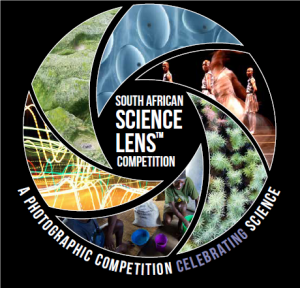

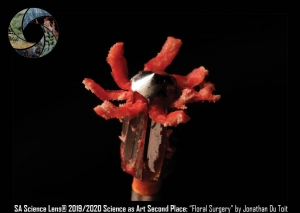
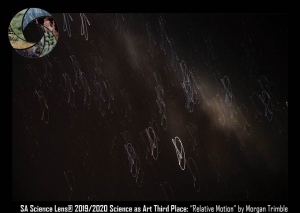
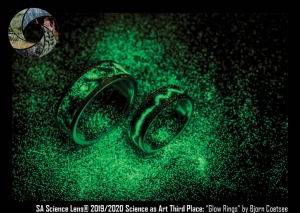
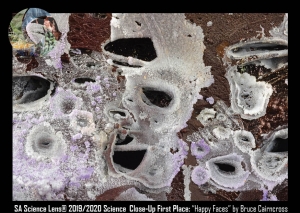
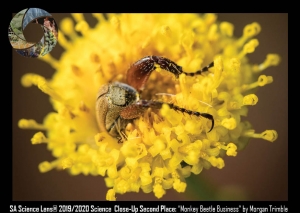
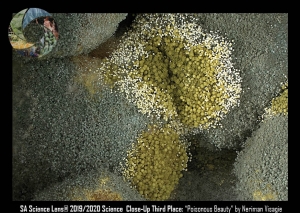
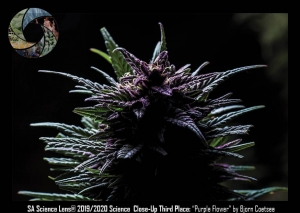
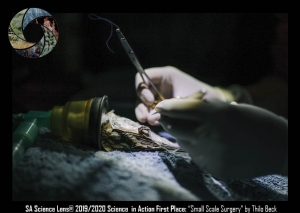
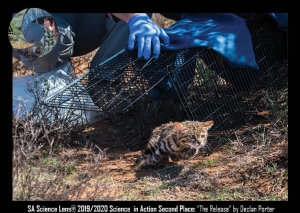
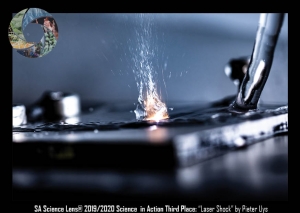
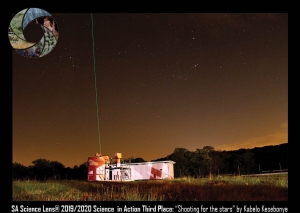
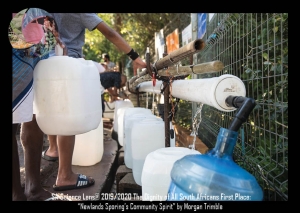
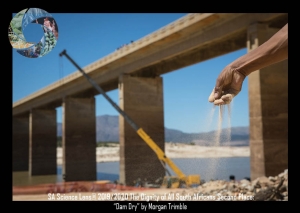
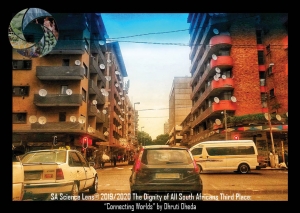
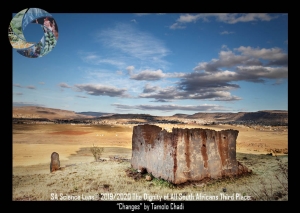
 The South Africa Agency for Science and Technology Advancement (SAASTA) is a business unit of the
The South Africa Agency for Science and Technology Advancement (SAASTA) is a business unit of the